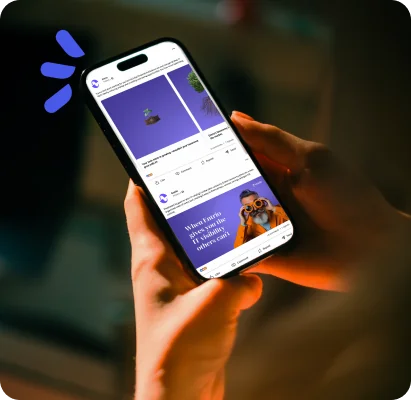
Inbound marketing is a powerful way to attract potential customers and nurture leads, but your efforts shouldn’t stop the moment someone fills out a form. To truly capture prospect interest and turn it into revenue, you need a smart, structured way to evaluate leads and act fast when the timing is right.
Strike at the exact right moment, and you could land a new customer. Strike too early or too late, and you lose the chance to even be part of the conversation.
That’s where proper lead scoring and marketing qualified lead (MQL) follow-up come in. (Some say MQLs are dead—we disagree.)
This blog walks through how to set up a lead scoring system, when and how to follow up with MQLs, and best practices to convert more of your inbound leads into customers.
What is lead scoring?
As a marketer, understanding the cues and patterns in your audience helps you identify which contacts are worth passing to sales. Your goal is to hand over quality leads, and lead scoring helps you get there.
In the simplest of terms, lead scoring is the process of assigning values to leads based on:
- Who they are (e.g., job title, industry)
- Where they work (e.g., company name, company size, revenue)
- How they engage with your content (e.g., downloads, website visits, email opens)
This system helps you prioritize leads that align with your Ideal Customer Profile (ICP) and are more likely to convert now. This saves your sales team time in trying to qualify every contact and it also increases your close rates.
Step 1: Setting Your MQL Threshold
Every company defines an MQL differently and your framework should match your unique definition as closely as possible. For example,
- If your target market is mostly C-Suite decision-makers, those titles should garner a higher score than, say, a manager.
- A product page download should carry more weight than a blog view.
The key is to set a scoring threshold that reflects your experience and instinct, one that signals when a lead is truly ready for sales outreach.
Let’s say you’re just starting out and your MQL threshold is 15 points. You might assign:
- 5 points for being a CFO
- 4 points for working at a company with more than 10,000 employees
- 3 points for downloading a whitepaper
- 2 points for visiting your pricing page
- 1 point for reading a blog
Once a lead hits 15 points, they’re flagged as an MQL.
Pro tip: If you’re new to lead scoring, review your model every 1–3 months and loop sales into that conversation. Are the MQLs you're handing off actually converting? If not, tweak your threshold and scoring model. Your audience behavior and sales goals will evolve, and your scoring model should too.
Want to dig deeper? Check out HubSpot’s guide to lead scoring for more frameworks and examples.
Step 2: MQL Follow Up—Timing Is Everything
Once a lead crosses your MQL threshold, the clock starts ticking, and how fast you respond can make or break the opportunity.
When Should I Follow Up?
- If an MQL requests a demo, fills out a sales contact form or asks for a consultation, aim to follow up within 10 minutes. Your chances of connecting are significantly higher.
- If they haven’t directly requested contact but they’ve met your lead scoring threshold, reach out within 24 hours while you're still top of mind.
Pro tip: Don’t wait too long! Your chance of converting an MQL into a sales opportunity drops by 15% for every day you delay. 78% of leads purchase from the company that first responds to their inquiry, and conversions are 391% higher when lead response time is in the first minute. (Source: Image Building Media).
Even if the lead isn't expecting a call, they’re actively researching and evaluating solutions. This means they’re likely on your competitor’s radar too. Be the first to offer value, and you’re much more likely to close.
Step 3: Setting a Follow-Up Cadence
So, how often should you reach out? For inbound MQLs, we recommend at least 6–10 touchpoints across multiple channels (email, phone, social media). This keeps your company top of mind and increases the odds of connecting when the timing is right.
Here's a proven cadence based on guidance from SalesHacker CEO Max Altschuler:
- Day 1: Email or LinkedIn InMail
- Day 3: Morning email + afternoon call
- Day 5: Morning call + afternoon voicemail
- Day 7: Morning email + afternoon voicemail
- Day 10: Morning email + morning call
Best Days & Times to Reach Out
- Best times to call: 8–9 AM and 4–5 PM (prospect’s time zone)
- Worst time: 1–2 PM (lunch slump)
- Best days: Wednesday and Thursday
According to Robert Clay, the founder of Marketing Wizdom, 80% of MQLs take 4+ touches to close—so persistence matters.
Step 4: Crafting the Right Message
You’ve nailed your timing and set a follow-up cadence—now it's time to focus on what you're actually saying.
Spoiler: this is not the moment for a hard sell.
Your goal is to provide value, build trust and spark interest without sounding pushy (or worse, landing in the spam folder).
Your message should add value. Try:
- Sharing a relevant industry article or content offer
- Referencing a mutual connection (can make them 5x more likely to engage)
- Responding to their social post or activity
- Offering a useful suggestion (like a blog or webinar idea)
- Sending a case study that highlights a customer success story
The goal: position yourself as a trusted advisor, not just another salesperson. Make sure every touchpoint answers: “Why is this worth the MQL’s time?”
Step 5: You’ve Made Contact–now what?
Congrats! You’ve started the conversation. Now it's time to build a real connection and confirm whether this lead is the right fit.
Here's how to steer that conversation:
- Ask about their organization and uncover pain points.
- Reference content they've downloaded, and ask what caught their interest.
- Gauge where they are in the buying process and what kind of solution they're exploring.
- Don’t jump into a full-blown sales pitch. Nothing kills momentum faster than sounding like a used car salesman.
If the lead is a good fit and timing aligns, try to:
- Book a discovery call
- Schedule a demo
If they're a good fit but the timing is off, shift them into a nurture stream and continue gathering intel for future outreach.
And if they're not the right one? Thank them for their time, disqualify the lead and make sure your CRM reflects the update. (Future-you will thank you.)
Don't Let Good Leads Go Cold
Combining a lead scoring strategy with fast, thoughtful follow-up can make or break your sales results. When done right, you’ll spend less time chasing dead ends and more time closing deals.
If building a lead scoring model or mapping a high-converting outreach plan feels like a stretch, we’ve got you.
Request a consultation with Accelity and we’ll help you convert more leads into customers, faster.
Subscribe to our newsletter
Curated content, news articles, team updates and more.



